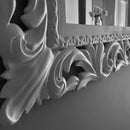Introduction: Diy-Ban - the Wooden Sunglasses
Hello today I want to tell you the story of my Diy-Ban sunglasses.
I'm Italian, sorry sometimes my English it is not always correct.
I used a type of tropical wood known as Ipè is very heavy, hard and stable.
Step 1: CAD: the Model 3D
With 3D studio Max I modeled the frame, previously downloaded from the web, and adapted to allow a correct 3d milling.
I exported n. 3 .STL files (one frame and two temple) and I imported into the Cut3D software, generating gcode for 12 milling, roughing and finishing on both sides.
Step 2: CAM and Setup for 3D Milling
The front will be made from a piece of Ipè of dimensions 80 x 180 x 23.3 (z) mm. I added the tabs in the most fragile points but also simpler for their removal.
After setting the size of the block i have chosen the parameters of the roughing and finishing.
The wood in question is very hard so I set for roughing a depth of cut of 1 mm and 2.6 mm stepover, finishing with stepover 0.3 mm
I generated 4 Gcode for milling the front (roughing and finishing on 2 sides) and then i generated 8 files for the temples with the same procedure, the only difference is that the block had this dimensions: 80 x 180 x 15.7 (z) mm.
You can open this files with this software:
Vectric Cut3D (.v3d)
Vectric Aspire (.crv3d)
Step 3: Preparation of the Milling Support
The most delicate part is be milled on both sides of a block in such a way that once rotated by 180 ° the zero point coincides with the edge opposite.
For this it is essential that the blocks to be milled have the same size set in the CAM with a precision possibly the tenth of a millimeter.
In addition to this it is necessary to also have a locking system (and unlocking) piece that allows a rotation of 180 ° without deviations.
So I fixed on the floor of my CNC a piece of birch plywood on which I milled pocket of the exact size of the blocks which for convenience I made the same size (80x180) 5 mm deep.
The purpose of the pocket is to be able to set us inside the blocks to be machined without losing the alignment in the X and Y axes as well as to have a perfectly linear sull'azze Z.
The first block is ready to be processed but must be held in place to prevent movement in Z.
Step 4: The Milling Begins...
After the hard work of CAD and CAM now I expect the final exam, see the final result and hope that the end milling successful considering the fact that only the front the CNC has been working continuously for 7 hours.
To mill all the three blocks (front and back) my cnc spent nine hours.
Step 5: Manual Finishing
After releasing all 3 pieces from the tabs I've hand-finished with sandpaper lightly just trying to soften the forms and eliminating the milling pass.
Then I anointed with the oil of linseed and wiping with a cloth beeswax make them shiny and pleasant to the touch.
Step 6: Hinges
Probably find a way to fix the hinges to the frame is the most complicated, at least it was for me.
It seems incredible, but on the internet I could not find a store that would sell. I only found a shop in Italy that sells beautiful metal hinges with micro-screws and nut but only in a kit for 10 pairs of glasses at a cost of about 80 Euros, I asked if I could send only a pair of glasses but answer was: no!
So I tried to recover the hinges from old celluloid glasses but are embedded in plastic and adapt them to a wooden frame is not easy at all.
So I decided to make do (as usual) and I decided to print them in 3D with my 3D printer.
Based on the measurements of my glasses I modeled with 3D Studio Max, a micro-hinge as that in the image above
I exported the model in .STL I tried to print it in ABS.
As pin i will use a needle sewing custom.
Attachments
Step 7: Pockets for the Hinges
Another delicate operation is to make small pockets to house the hinges in the frame and temples.
With a micro milling machine and a tool of 0.75 mm and especially with a lot of patience I carved small pockets.
Later I made the holes (diameter 1.2 mm) to insert the micro-screws with nut
Step 8: Grooves for the Lenses
To be able to mount the lenses must be formed in the inner part of the front of the incisions so as to allow a perfect fit.
Always with a tool 0.75 mm going very slowly I made an incision of about 1mm depth along the inside perimeter.
Step 9: Custom Logo Laser Engraving
This particular could not miss ... I had to mark them in some way
Engrave the words "Ray-Ban" was too trivial, "Diy-Ban" instead is more appropriate given the context.
With Aspire Vectric I prepared written and exported gcode for machining a pocket with my cnc laser.
Step 10: Assembly the Temples
I'm not a optician nor a watchmaker and these operations bring me a bit of stress.
I bought on Ebay of micro-screws M1,2 + nut that I will use for tightening the hinges.
Probably This is for me the most delicate part of this project.
I admit that the assembly of temples did not come very well, I'll do better next time. My next project is about sunglasses using curved sheets of veneer.
Thanks for reading!










